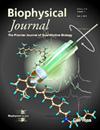对趋磁细菌运动的显式分析揭示了磁矩的长度标度
IF 3.2
3区 生物学
Q2 BIOPHYSICS
引用次数: 0
摘要
趋磁细菌(MTB)是一种多样化的微生物群,其运动可以通过磁场来引导,这使得它们在医学和微流体领域的应用具有吸引力。它们的关键特性之一是磁矩m,这是一个具有挑战性的测量。我们对MSR-1 MTB进行了光学成像实验,并使用一种显式和全自动的方法从MTB轨迹中确定m,该方法基于MTB在外加交变磁场中显示的u形轨迹来测量m,从而得出m的统计量和m与MTB尺寸的比例。所提出的方法是一种替代标准的基于时间的弯矩计算方法,并使用了我们推导的理论u形函数。这直接解释了u型转弯的几何形状,并决定了u型转弯分支宽度的力矩。我们将这种方法与一种鲁棒的u型转弯分解算法相结合,该算法可以检测来自MTB轨道的u型转弯,而不管它们的方向如何。我们报告了细菌大小对m的线性依赖,考虑了u型转弯期间细菌速度的变化。我们还表明,新的基于u形的方法和传统的基于时间的方法产生显著不同的结果。所提出的方法可用于根据速度和磁矩来区分同一种群中不同类型的结核分枝杆菌,并精确表征培养物的磁性。本文章由计算机程序翻译,如有差异,请以英文原文为准。
Explicit analysis of magnetotactic bacteria motion reveals the length scaling of magnetic moments
Magnetotactic bacteria (MTB) are a diverse group of microorganisms whose movement can be directed via a magnetic field, which makes them attractive for applications in medicine and microfluidics. One of their key properties is the magnetic moment m , which is challenging to measure. We perform optical imaging experiments with MSR-1 MTB, and derive both the m statistics and the scaling of m with the MTB size using an explicit and fully automated method to determine m from the MTB trajectories via the U-turn protocol, which measures m based on the U-shaped trajectories exhibited by the MTB in an applied alternating magnetic field. The proposed method is an alternative to the standard U-turn time-based moment calculation and uses the theoretical U-turn shape function we have derived. This directly accounts for the U-turn geometry and determines the moment from the U-turn branch width. We couple this approach with a robust U-turn decomposition algorithm that detects U-turns from MTB tracks regardless of their orientations. We report a linear dependence of m on the size of the bacteria, accounting for the bacteria velocity variations during the U-turns. We also show that the new U-turn shape-based and the conventional time-based methods produce significantly different results. The proposed method can be used to differentiate between various types of MTB within the same population based on their velocity and magnetic moments, and to precisely characterize the magnetic properties of a culture.
求助全文
通过发布文献求助,成功后即可免费获取论文全文。
去求助
来源期刊

Biophysical journal
生物-生物物理
CiteScore
6.10
自引率
5.90%
发文量
3090
审稿时长
2 months
期刊介绍:
BJ publishes original articles, letters, and perspectives on important problems in modern biophysics. The papers should be written so as to be of interest to a broad community of biophysicists. BJ welcomes experimental studies that employ quantitative physical approaches for the study of biological systems, including or spanning scales from molecule to whole organism. Experimental studies of a purely descriptive or phenomenological nature, with no theoretical or mechanistic underpinning, are not appropriate for publication in BJ. Theoretical studies should offer new insights into the understanding ofexperimental results or suggest new experimentally testable hypotheses. Articles reporting significant methodological or technological advances, which have potential to open new areas of biophysical investigation, are also suitable for publication in BJ. Papers describing improvements in accuracy or speed of existing methods or extra detail within methods described previously are not suitable for BJ.
 求助内容:
求助内容: 应助结果提醒方式:
应助结果提醒方式:


